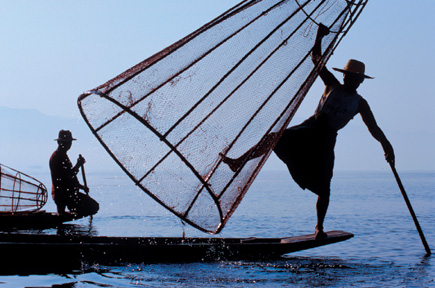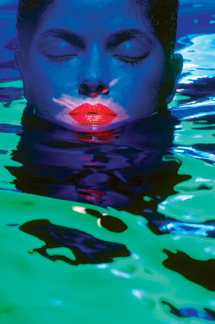An Interview With Eric Meola; Passion, Belief, & Risk Page 2
EM: I think it's different for different people, both for the viewers and the photographer. Take Cartier-Bresson, who always went for the decisive moment. I think only he would know when the decisive moment was. It could be different for you or for me. I don't have any regrets about using the intellectual approach when it worked, but it reached the point where it wasn't working for me anymore. I was ready to make that change. It didn't matter that 50 percent of the images might be blurred or unsharp or whatever because of a lack of technique, I had to do it. I had to see what it looked like.
Fishermen |
 |
SB: When did you begin to shoot digitally?
EM: I started shooting digitally about three years ago, my
first digital camera was the Canon EOS-1Ds. Until recently I didn't think
that the quality was there. It's really been the evolution of three things--the
computers, the software, and the cameras--that allowed me to finally move
into it. I don't shoot film anymore. The workflow was the bear of the
transition, not the cameras or the other technology. It also brought in a huge
change in how you could catalog your work. I've been scanning since the
late '80s because I realized everything was going to transition to electronic
submission. But back then computers weren't powerful enough.
SB: Could you describe your typical workflow from shooting
to finished images?
EM: I shoot raw with the Canon EOS-1Ds Mark II. I preview on
the back of the camera and I tend to leave most of the editing until later on.
Up until recently I've been using Photoshop CS2 but will be trying Mac's
Aperture.
SB: Has shooting digitally changed your vision or do you see
it as a different tool to accomplish what you would have done yourself anyway?
EM: I don't know that it's changed my vision. I
do think it's an incredible tool. I can experiment a lot more with digital.
I shoot things that I might not normally photograph or think might not make
a good picture. I can always edit it or just erase the images. In that sense
it has changed the way I shoot.
SB: Early in your career you shot images as the start of an
enhancement process, using duping or other techniques to intensify color or
the graphic quality of the image.
EM: Yes, but I don't feel that way at all now. I try
to process the image to capture what I saw with my mind's eye. Now that's
obviously not always going to agree with what was really out there, but then,
what was really out there?
Fire Eater |
 |
SB: Was that what you were doing with film 30 years ago?
EM: No. Thirty years ago I was intellectualizing more, thinking
about multiple exposing or radically altering with duping later to change the
image. Now I tend to do what I see in my mind's eye but it's a lot
more realistic. If you were somehow able to show the original subject next to
my finished images 30 years ago, compared to the way I'm shooting now,
most people would see my current work as more natural and normal.
SB: You have been working with Photoshop since the very beginning,
scanning film before you began shooting digitally.
EM: I've been using Photoshop since the early '90s
but use it as a tool to work with my images, as opposed to altering them. It
all comes down to who we are as photographers and what we are trying to do with
our images. I'm very careful about how I process my images both from a
technical standpoint and with an understanding of what the image looked like
originally.
SB: You were a success for many years in the advertising field
but the whole business of photography is changing. What do you see as the good
and bad from those changes?
EM: A lot of good new photographers aren't getting an
opportunity to make a living. I made my reputation in advertising photography.
But only 2 percent of my time was spent making photographs; 98 percent of my
time was spent bidding, putting the job together, and dealing with all the personalities
to make everyone happy. In the end you can't make everyone happy and I
didn't become a photographer to spend only 2 percent of my time making
images.
SB: What kind of advice would you give to photographers who
are trying to establish themselves today?
EM: It always comes back to my original belief of having passion.
You can't just generate passion; you've really got to have it from
the beginning. You need to believe in yourself and in your projects. Very early
in your career you need to shoot things that you believe in, things that you
really want to shoot. You need to take risks. Don't wait for the phone
to ring. Success is only going to happen if you are out there really working
to make it happen.
In 2004 Eric Meola's first book, "Last Places on Earth," was
published. Sponsored by Eastman Kodak, it is an exploration of the disappearing
beauty of various cultures, ceremonies, and wildlife in many remote areas of
the world at the end of the 20th century. Meola is also a popular speaker in
the Canon "Explorers of Light" program of distinguished photographers.
His website is www.ericmeola.com.
Larry Berman and Chris Maher are photographers, writers, and web designers, specializing in image intensive photography sites. For more information visit their websites at: www.BermanGraphics.com and www.InfraredDreams.com.
- Log in or register to post comments

















































